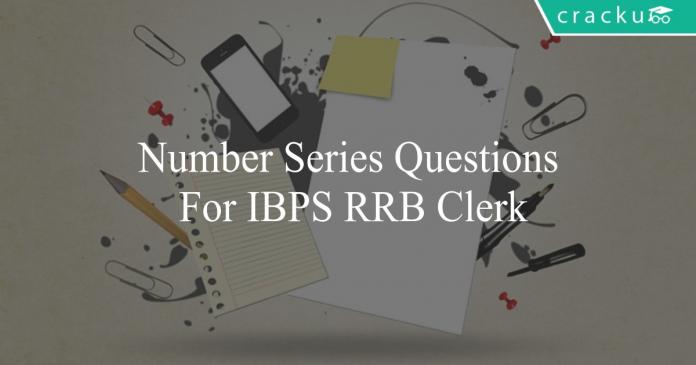Number Series Questions For IBPS RRB Clerk
Download Top-20 IBPS RRB Clerk Number Series Questions PDF. Number Series questions based on asked questions in previous year exam papers very important for the IBPS RRB Assistant exam.
Download Number Series Questions For IBPS RRB Clerk
35 IBPS RRB Clerk Mocks @ Rs. 149
70 IBPS RRB (PO + Clerk) Mocks @ Rs. 199
Question 1: In the number series below which element doesn’t fit in?
78, 101, 124, 147, 169, 193
a) 101
b) 193
c) 169
d) 147
e) None of these
Question 2: Find the wrong number in the series.
14, 16, 19, 24, 31, 42, 51
a) 51
b) 31
c) 19
d) 42
e) None of these
Question 3: Find out the wrong number in the series:
8, 11, 20, 47, 130, 371
a) 20
b) 47
c) 130
d) 371
e) None of these
Question 4: Find the wrong number in the series.
85, 81, 88, 84, 91, 86, 94
a) 88
b) 91
c) 86
d) 81
e) None of these
Question 5: Find the wrong number in the series.
16, 18, 23, 31, 44, 56
a) 23
b) 31
c) 44
d) 56
e) None of these
Question 6: Find out the wrong number in the series:
51, 52, 50, 53, 49, 54, 47
a) 50
b) 53
c) 47
d) 49
e) None of these
Question 7: Find out the wrong number in the series:
6, 8, 12, 20, 34, 68
a) 8
b) 12
c) 20
d) 34
e) None of these
Question 8: Find the wrong number in the series.
41, 55, 67, 79, 91
a) 91
b) 55
c) 79
d) 41
e) None of these
Question 9: Find the wrong number in the series.
32, 48, 72, 110, 162
a) 48
b) 110
c) 72
d) 162
e) None of these
Free Mock Test for IBPS RRB PO
IBPS RRB Clerk Previous Papers
Question 10: Find the number which should replace ‘?’
99, 63, 38, 22, 13, ?
a) 10
b) 8
c) 12
d) 7
e) 9
Question 11: Find the number which should replace ‘?’
52, 50, 45, 43, 38, 36, ?
a) 33
b) 34
c) 28
d) 31
e) 35
Question 12: Find the number which should replace ‘?’
2, 5, 12, 23, ?
a) 37
b) 38
c) 39
d) 40
e) 41
Question 13: Find the number which should replace ‘?’
5,13,25,41, ?
a) 61
b) 56
c) 59
d) 52
e) 65
Instructions
What will come in place of question mark ‘?’ in the following number sequences?
Question 14: 2, 5, 14, 71, ?
a) 632
b) 679
c) 711
d) 634
e) None of the above.
Question 15: 15, 35, 63, ?, 143
a) 99
b) 117
c) 91
d) 95
e) None of the above
Question 16: 5, 12, 31, 86, ?
a) 168
b) 192
c) 249
d) 207
e) 256
Question 17: 4, 9 , 25, 49, 121, ?
a) 144
b) 155
c) 164
d) 196
e) 169
Question 18: 2 , 6 , 30 , 260 , ?
a) 1029
b) 1030
c) 3129
d) 3130
e) None of the above
Instructions
Find the number which should replace ‘?’
Question 19: 27, 108, 36, 144, 48, 192, 64, ?
a) 216
b) 123
c) 212
d) 256
e) 272
Question 20: 2, 10, 30, 68, 130, ?
a) 213
b) 197
c) 267
d) 313
e) 222
Quantitative Aptitude formulas PDF
520 Banking Mocks – Just Rs. 499
Answers & Solutions:
1) Answer (C)
78 + 23 = 101
101 + 23 = 124
124 + 23 = 147
147 + 23 = 170
170 + 23 = 193
Hence, option C is the right answer.
2) Answer (A)
The difference between the first term and the second term = 2
The difference between the second term and the third term = 3
The difference between the third term and the fourth term = 5
The difference between the fourth term and the fifth term = 7
The difference between the fifth term and the sixth term = 11
So, the difference between consecutive terms is a series of prime number starting from 2.
The difference between the sixth and the seventh term should be 13.
The seventh term = 42 + 13 = 55 but it is 51. So, the seventh term is incorrect.
Hence, option A is the correct answer.
3) Answer (C)
The difference between the first term and the second term = $3^1 = 3$
The difference between the second term and the third term = $3^2 = 9$
The difference between the third term and the fourth term = $3^3 = 27$
So, the difference is increasing in power of 3.
The difference between the fourth and the fifth term should be $3^4 = 81$
The fifth term = 47 + 81 = 128.
So, the term ‘130’ is incorrect.
Hence, option C is the correct answer.
4) Answer (C)
$T_{2} – T_{1}$ = 81 – 85 = -4
$T_{3} – T_{2}$ = 88 – 81 = 7
$T_{4} – T_{3}$ = 84 – 88 = -4
$T_{5} – T_{4}$ = 91 – 84 = 7
We can see the pattern hence for next term
$T_{6} – T_{5}$ = -4
$\Rightarrow$ $T_{6}$ = 91 +(- 4) = 87
Similarly $ T_{7} – T_{6}$ = 7
$\Rightarrow$ $ T_{7}$ = 7 + 87 = 94
Hence we can say that ‘86’ mentioned in the original sequence is incorrect. (Answer :C)
18000 Free Solved Questions – Banking Study Material
35 IBPS RRB Clerk Mocks @ Rs. 149
5) Answer (C)
We can see that
$T_{2} – T_{1}$ = 18 – 16 = 2
$T_{3} – T_{2}$ = 23 – 18 = 5
$T_{4} – T_{3}$ = 31 – 23 = 8
We can see that the difference is increasing by 3.
$T_{5} – T_{4}$ = $T_{5}$ – 31 = 8 + 3
$\Rightarrow$ $T_{5}$ = 42 and $T_{6}$ = 42+(11+3) = 56
Hence we can say that ‘44’ is the incorrect term in the sequence. (Answer :C)
6) Answer (C)
1st term is increased by 1, 2nd term is decreased by 2, 3rd term is increased by 3 and so on. 6th term must be decreased by 6. So, 7th term should be 48. Hence, 7th term that is 47 is incorrect.
7) Answer (D)
Difference between 1st and 2nd term is 2.
Difference between 2nd and 3rd term is 4.
Difference between 3rd and 4th term is 8.
Hence, the difference is getting doubled.
So, difference between 4th and 5th term must be 16 and 5th term should be 36. Hence, 5th term that is 34 is incorrect.
8) Answer (D)
43+ 12 = 55
55 + 12 = 67
67 + 12 = 79
79 + 12 = 91
Hence, option D is the right answer.
9) Answer (B)
32 * 1.5 = 48
48 * 1.5 = 72
72*1.5 = 108
108 * 1.5 = 162
Hence, option B is the right answer.
10) Answer (E)
Finding out difference between two consecutive term
$T_{1} – T_{2}$ = 99 – 63 = 36
$T_{2} – T_{3} $= 63 – 38 = 25
$T_{3} – T_{4}$ = 38 – 22 = 16
$T_{4} – T_{5}$ = 22 – 13 = 9
Clearly the difference is square of natural number in decreasing order starting from 6.
$T_{5} – T_{6}$ = $2^{2}$
$T_{6}$ = 13 – 4 = 9
11) Answer (D)
Calculating the difference between consecutive terms,
$T_{1} – T_{2} = 52 – 50 = 2$
$T_{2} – T_{3} = 50 – 45 = 5$
$T_{3} – T_{4} = 45 – 43 = 2$
$T_{4} – T_{5} = 43 – 38 = 5$
$T_{5} – T_{6} = 38 – 36 = 2$
By analysing the difference between consecutive terms we can figure out that number 2, 5 are being subtracted alternatively so next term will be = 36 – 5 = 31
12) Answer (B)
We can see that difference between two consecutive terms is increasing.
$T_{2} – T_{1}$ = 5 – 2 =3
$T_{3} – T_{2}$ = 12 – 5 = 7
$T_{4} – T_{3} $= 23 – 12 = 11
Clearly the difference is in A.P with common difference of 4.
So $T_{5} – T_{4}$ = 11+4
$T_{5}$ = 15 + 23 = 38
13) Answer (A)
We can see that every term is sum of square of 2 consecutive natural numbers starting from 1.
$1^{2}+2^{2}$ = 1+4 = 5
$2^{2}+3^{2}$ = 4+9 = 13
$3^{2}+4^{2}$ = 9+16 = 25
$4^{2}+5^{2}$ = 16+25 = 41
$5^{2}+6^{2}$ = 25+36 = 61
14) Answer (D)
$1 + (1^{0}+0) = 2$
$2 + (2^{1}+1) = 5$
$3 + (3^{2}+2) = 14$
$4 + (4^{3}+3) = 71$
$5 + (5^{4}+4) = 634$
15) Answer (A)
We can see that
3 * 5 = 15
5 * 7 = 35
7 * 9 = 63
9 * 11 = 99
11 * 13 = 143. Hence answer (a)
16) Answer (C)
$3^{1} + 2 = 5$
$3^{2} + 3 = 12$
$3^{3} + 4 = 31$
$3^{4} + 5 = 86$
So next term will be $3^{5} + 6 = 249$ .
17) Answer (E)
We can see that above mentioned sequence is square of prime numbers.
$2^{2}, 3^{2}, 5^{2}, 7^{2}, 11^{2}, …$
So next term will be $13^{2} =169$
18) Answer (D)
We can see that
$1^{1}+1 = 2$
$2^{2}+2 = 6$
$3^{3}+3 = 30$
$4^{4}+4 = 260$
So $5^{5}+5 = 3125 + 5 = 3130$
19) Answer (D)
The series follows the following pattern:
27
27 * 4 = 108
108 / 3 = 36
36 * 4 = 144
144 / 3 = 48
48 * 4 = 192
192 / 3 = 64
64 * 4 = 256
20) Answer (E)
The series follows the following pattern:
$1 + 1^3 = 2$
$2 + 2^3 = 10$
$3 + 3^3 = 30$
$4 + 4^3 = 68$
$5 + 5^3 = 130$
$6 + 6^3 = 222$





